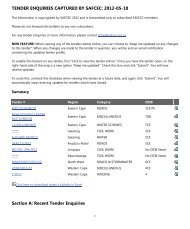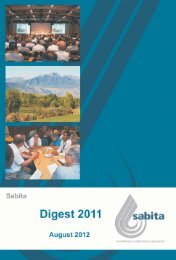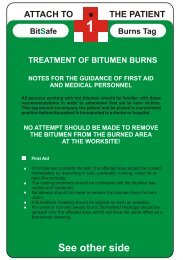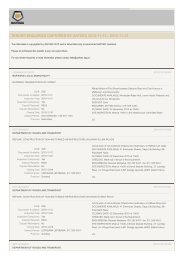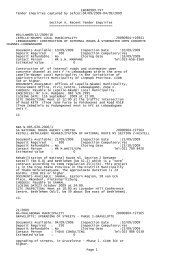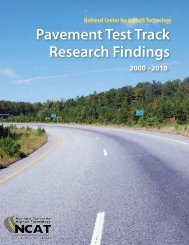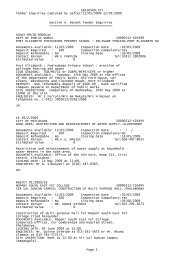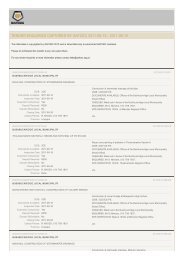DIGEST 2006 - Sabita
DIGEST 2006 - Sabita
DIGEST 2006 - Sabita
You also want an ePaper? Increase the reach of your titles
YUMPU automatically turns print PDFs into web optimized ePapers that Google loves.
oad construction. As mentioned<br />
previously, the weathering of the<br />
aggregate is of utmost importance<br />
to the stability of the aggregate,<br />
and is considered to be one of the<br />
most important aspects of raw<br />
materials handling.<br />
Steel slag asphalt mixes<br />
The objective of investigating steel<br />
slag asphalt mixtures was to<br />
produce a rut resistant asphalt for<br />
application where traffic loading is<br />
high, vehicle speeds low, and<br />
environmental conditions varying.<br />
Trial steel slag asphalt mixes were<br />
prepared for use during the N3<br />
Toll Concession (N3TC) routine<br />
maintenance contract between<br />
Heidelberg and Cedara.<br />
A mix design was completed using<br />
the steel slag as an aggregate,<br />
along with a filler to satisfy the<br />
-0,075mm grading limits. The<br />
grading specification used for the<br />
mix design was according to TRH8<br />
(Coarse). A 4% SBS modified<br />
binder was used to enhance the<br />
natural properties of the bitumen<br />
by making the binder more elastic<br />
at higher temperatures, which in<br />
turn enables the binder to<br />
withstand repeated traffic loading<br />
and reduces rutting potential.<br />
Results<br />
For the mix adopted, the<br />
specification required a stability<br />
within the range 8,0 kN – 18,0 kN.<br />
Test results indicated a stability in<br />
the region of 15,0 kN. This can in<br />
part be attributed to both the use<br />
of steel slag as an aggregate, and<br />
to the polymer modified binder.<br />
The higher stability indicated that<br />
the mix was ideally suited to the<br />
requirements of a deformation<br />
resistant asphalt surfacing. The<br />
maximum flow recorded at the<br />
various binder contents tested was<br />
4mm compared to the recommended<br />
range of 2 – 6mm.<br />
The Indirect Tensile Strength (ITS)<br />
of the mix is a measure of the<br />
stiffness of an asphalt mix i.e. how<br />
well it distributes loading to<br />
underlying layers. In the Interim<br />
guidelines for the design of hot<br />
mix asphalt in South Africa 2001,<br />
the minimum recommended<br />
stiffness for a surfacing mix is<br />
1000 kPa. The stiffness of the<br />
steel slag mix design reported,<br />
1280 kPa, is significantly higher<br />
than this minimum requirement.<br />
The above document also<br />
recommends a minimum Voids in<br />
Mineral Aggregate (VMA) of<br />
15,0%. Low VMA asphalt mixes<br />
tend to be sensitive to changes in<br />
binder content and create tender<br />
mixes that may be more inclined<br />
to rutting and bleeding. The<br />
minimum VMA recorded for the<br />
binder contents tested – 16,3% –<br />
exceeds the minimum requirement<br />
and is suited to a rut resistant and<br />
durable asphalt surfacing.<br />
To optimise void content to<br />
counter air and water permeability<br />
on the one hand, and fattiness and<br />
bleeding on the other, a target<br />
Voids in Mix (VIM) of 4% was<br />
adopted, as suggested by<br />
Superpave 2001. The reported<br />
results for the steel slag mix<br />
design, was very close to the<br />
optimum voids content of 4%, and<br />
the mix met the requirement for<br />
76



